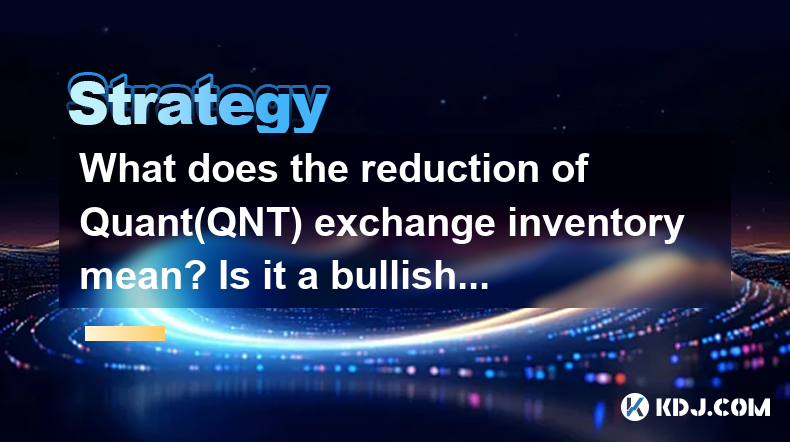-
 bitcoin
bitcoin $122025.899241 USD
-2.12% -
 ethereum
ethereum $4488.068729 USD
-4.11% -
 bnb
bnb $1315.348019 USD
8.65% -
 tether
tether $1.000457 USD
0.03% -
 xrp
xrp $2.875326 USD
-3.69% -
 solana
solana $222.043604 USD
-4.07% -
 usd-coin
usd-coin $0.999682 USD
0.00% -
 dogecoin
dogecoin $0.249887 USD
-5.62% -
 tron
tron $0.337379 USD
-2.59% -
 cardano
cardano $0.827763 USD
-5.06% -
 hyperliquid
hyperliquid $45.774531 USD
-2.43% -
 chainlink
chainlink $22.079309 USD
-5.87% -
 ethena-usde
ethena-usde $1.000156 USD
0.02% -
 sui
sui $3.482566 USD
-3.57% -
 stellar
stellar $0.386982 USD
-4.92%
What does the reduction of Quant(QNT) exchange inventory mean? Is it a bullish signal?
A reduction in QNT exchange inventory can signal strong demand and potential price increases, but it should be analyzed with other market factors for a comprehensive view.
May 04, 2025 at 01:21 am

The reduction of Quant (QNT) exchange inventory refers to a decrease in the amount of QNT tokens available on cryptocurrency exchanges. This phenomenon can have several implications for the token's market dynamics and is often scrutinized by investors and traders to gauge potential price movements. In this article, we will explore what a reduction in QNT exchange inventory means and whether it can be considered a bullish signal.
Understanding Exchange Inventory
Exchange inventory represents the total amount of a cryptocurrency, in this case, QNT, that is held on various trading platforms. This inventory is crucial because it directly affects the liquidity and potential price volatility of the token. When the inventory on exchanges decreases, it means that fewer tokens are available for trading, which can influence the token's market behavior.
Reasons for Reduction in QNT Exchange Inventory
There are several reasons why the inventory of QNT on exchanges might decrease. One primary reason is increased buying pressure. When more investors and traders are buying QNT than selling it, the net effect is a reduction in the available supply on exchanges. This can happen due to positive news, increased adoption, or general market sentiment favoring the token.
Another reason could be holders moving their tokens to cold storage. Investors who believe in the long-term value of QNT might transfer their tokens from exchange wallets to more secure offline storage solutions. This action reduces the circulating supply on exchanges, which can lead to a decrease in inventory.
Additionally, token burns or buybacks by the project team can also contribute to a reduction in exchange inventory. If Quant decides to buy back and burn a portion of its tokens, this would directly decrease the total supply available on exchanges.
Impact on Market Dynamics
A reduction in QNT exchange inventory can have several impacts on the market dynamics of the token. Reduced liquidity is one immediate effect. With fewer tokens available for trading, it can become more difficult to buy or sell large amounts of QNT without significantly affecting the price. This can lead to increased price volatility, as smaller trades can have a more pronounced impact on the market.
Increased demand is another potential impact. If the demand for QNT remains constant or increases while the supply on exchanges decreases, this can lead to upward pressure on the token's price. Investors and traders might interpret a reduction in exchange inventory as a sign of strong demand and confidence in the token's future value.
Is a Reduction in QNT Exchange Inventory a Bullish Signal?
Whether a reduction in QNT exchange inventory is considered a bullish signal depends on the context and other market factors. In general, a decrease in exchange inventory can be seen as a positive sign. It suggests that more investors are holding onto their tokens rather than selling them, which can be interpreted as confidence in the project's future.
However, it is essential to consider other factors such as overall market sentiment, recent news and developments related to Quant, and technical indicators. A reduction in exchange inventory alone is not enough to determine a bullish trend. It should be analyzed in conjunction with other data points to form a more comprehensive view of the market.
Analyzing the Data
To determine whether a reduction in QNT exchange inventory is a bullish signal, investors and traders often look at several metrics. Trading volume is one key indicator. If the reduction in inventory is accompanied by high trading volume, it suggests strong market interest and can be a more reliable bullish signal.
Price action is another crucial factor. If the price of QNT is trending upwards alongside a reduction in exchange inventory, this can reinforce the bullish sentiment. Conversely, if the price is declining despite a decrease in inventory, it might indicate other underlying issues affecting the token's value.
On-chain metrics such as the number of active addresses and transaction volume can also provide insights. An increase in these metrics alongside a reduction in exchange inventory can indicate growing adoption and use of the token, further supporting a bullish outlook.
Practical Steps to Monitor QNT Exchange Inventory
For those interested in tracking the exchange inventory of QNT, there are several practical steps that can be taken:
- Use blockchain explorers: Websites like Etherscan or specialized platforms like Nansen can provide detailed data on the movement of QNT tokens, including transfers to and from exchanges.
- Monitor exchange wallets: Many exchanges publish their wallet addresses, allowing users to track the balance of QNT held on these platforms.
- Utilize market analysis tools: Platforms like CoinGecko or CoinMarketCap offer insights into exchange inventory and other market metrics that can help in analyzing the situation.
- Follow official announcements: Keeping an eye on Quant's official channels for any news about token burns, buybacks, or other actions that could affect exchange inventory is crucial.
Conclusion
In conclusion, a reduction in Quant (QNT) exchange inventory can be a significant indicator of market dynamics. While it can be seen as a bullish signal, it is essential to consider it alongside other market factors to form a comprehensive view. By understanding the reasons behind the reduction and monitoring relevant metrics, investors and traders can make more informed decisions about the potential impact on QNT's price.
Frequently Asked Questions
Q: How can I differentiate between a temporary reduction in QNT exchange inventory and a more sustained trend?A: To differentiate between a temporary reduction and a more sustained trend, it's important to monitor the inventory over an extended period. Look for consistent patterns over weeks or months rather than focusing on short-term fluctuations. Additionally, consider the context of the reduction, such as whether it coincides with significant news or developments related to Quant.
Q: Can a reduction in QNT exchange inventory lead to a price crash if it's due to a large holder moving tokens to cold storage?A: While a large holder moving tokens to cold storage can temporarily reduce the exchange inventory, it is unlikely to cause a price crash on its own. However, if the market perceives this action as a lack of confidence in the token's future, it could lead to increased selling pressure from other holders. It's essential to consider the overall market sentiment and other factors when assessing the potential impact on price.
Q: Are there any tools or platforms that provide real-time data on QNT exchange inventory?A: Yes, several tools and platforms offer real-time data on QNT exchange inventory. Blockchain explorers like Etherscan provide detailed transaction data, while market analysis platforms like Nansen and CoinGecko offer insights into exchange balances and other relevant metrics. These tools can help investors and traders stay updated on the latest inventory levels.
Q: How does the reduction in QNT exchange inventory compare to similar trends in other cryptocurrencies?A: The impact of a reduction in exchange inventory can vary across different cryptocurrencies. For QNT, the effect might be more pronounced due to its specific use case and market dynamics. Comparing QNT to other tokens involves looking at factors such as market cap, liquidity, and the project's overall adoption and development. While a reduction in inventory can generally be seen as a positive sign, the specific implications can differ based on the token's unique characteristics.
Disclaimer:info@kdj.com
The information provided is not trading advice. kdj.com does not assume any responsibility for any investments made based on the information provided in this article. Cryptocurrencies are highly volatile and it is highly recommended that you invest with caution after thorough research!
If you believe that the content used on this website infringes your copyright, please contact us immediately (info@kdj.com) and we will delete it promptly.
- BlockDAG, DOGE, HYPE Sponsorship: Crypto Trends Shaping 2025
- 2025-10-01 00:25:13
- Deutsche Börse and Circle: A StableCoin Adoption Powerhouse in Europe
- 2025-10-01 00:25:13
- BlockDAG's Presale Buzz: Is It the Crypto to Watch in October 2025?
- 2025-10-01 00:30:13
- Bitcoin, Crypto, and IQ: When Genius Meets Digital Gold?
- 2025-10-01 00:30:13
- Stablecoins, American Innovation, and Wallet Tokens: The Next Frontier
- 2025-10-01 00:35:12
- NBU, Coins, and Crypto in Ukraine: A New Yorker's Take
- 2025-10-01 00:45:14
Related knowledge

Practical parameter settings for a Bitcoin multi-timeframe moving average system
Sep 18,2025 at 10:54pm
Optimizing Timeframe Combinations for Bitcoin Trading1. Selecting appropriate timeframes is crucial when building a multi-timeframe moving average sys...

How can I filter out false breakouts in Dogecoin high-frequency trading?
Sep 22,2025 at 01:00am
Understanding False Breakouts in Dogecoin Trading1. A false breakout occurs when Dogecoin's price appears to move beyond a defined support or resistan...

Techniques for identifying tops and bottoms in the Bitcoin on-chain NVT model
Sep 20,2025 at 07:54pm
Understanding the NVT Model in Bitcoin Analysis1. The Network Value to Transactions (NVT) ratio is often described as the 'P/E ratio' of the cryptocur...

What does the surge in open interest in Bitcoincoin futures mean?
Sep 20,2025 at 11:18pm
Understanding the Surge in Dogecoin Futures Open Interest1. A surge in open interest within Dogecoin futures indicates a growing number of active cont...

How can I use the Ethereum USDT premium to gauge market sentiment?
Sep 18,2025 at 11:55pm
Understanding the Ethereum USDT Premium1. The Ethereum USDT premium refers to the price difference between USDT (Tether) traded on Ethereum-based plat...

What should I do if Ethereum staking yields decline?
Sep 20,2025 at 06:18am
Understanding the Causes Behind Declining Ethereum Staking Yields1. The Ethereum network transitioned to a proof-of-stake consensus mechanism with the...

Practical parameter settings for a Bitcoin multi-timeframe moving average system
Sep 18,2025 at 10:54pm
Optimizing Timeframe Combinations for Bitcoin Trading1. Selecting appropriate timeframes is crucial when building a multi-timeframe moving average sys...

How can I filter out false breakouts in Dogecoin high-frequency trading?
Sep 22,2025 at 01:00am
Understanding False Breakouts in Dogecoin Trading1. A false breakout occurs when Dogecoin's price appears to move beyond a defined support or resistan...

Techniques for identifying tops and bottoms in the Bitcoin on-chain NVT model
Sep 20,2025 at 07:54pm
Understanding the NVT Model in Bitcoin Analysis1. The Network Value to Transactions (NVT) ratio is often described as the 'P/E ratio' of the cryptocur...

What does the surge in open interest in Bitcoincoin futures mean?
Sep 20,2025 at 11:18pm
Understanding the Surge in Dogecoin Futures Open Interest1. A surge in open interest within Dogecoin futures indicates a growing number of active cont...

How can I use the Ethereum USDT premium to gauge market sentiment?
Sep 18,2025 at 11:55pm
Understanding the Ethereum USDT Premium1. The Ethereum USDT premium refers to the price difference between USDT (Tether) traded on Ethereum-based plat...

What should I do if Ethereum staking yields decline?
Sep 20,2025 at 06:18am
Understanding the Causes Behind Declining Ethereum Staking Yields1. The Ethereum network transitioned to a proof-of-stake consensus mechanism with the...
See all articles










































































